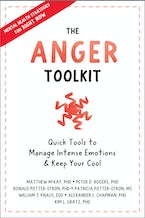By Matthew McKay, PhD, Peter Rogers, PhD, Ronald T. Potter-Efron, MSW, PhD, Patricia S. Potter-Efron, MS, William J. Knaus, EdD, Alexander L. Chapman, PhD, RPsych, Kim L. Gratz, PhD, coauthors of The Anger Toolkit
From the very start, it’s important to get one thing straight: you aren’t to blame because you struggle with anger. You are not a bad person because you’ve forgotten—perhaps repeatedly—all your resolutions to be cool and calm. Rather, you are a person in pain. Often the roots of anger can be traced back to earlier times when you were hurt, abused, or neglected in your family of origin. The pain was something you carried, year after year. It may have left scars so that now it’s hard to feel safe or loved or truly worthy. Sometimes it doesn’t take much of a provocation to trigger those feelings of being unloved, unworthy, or unsafe—and the anger rises up right alongside that old pain. Whether the pain is occasional or chronic, when it hits, it feels overwhelming. It’s a wave that drives you into a state of mind where nothing matters but expressing what you feel. You shout it out, no matter who gets hurt or whatever the consequences. Anger is a way of coping. It helps you, temporarily, to overcome the hurt and helplessness. For a moment you feel back in control, and that’s exactly why anger is so hard to manage. If you try to put a cork in your anger, you may feel acutely the pain that triggered it. So now is the time to stop kicking yourself. It doesn’t help. In fact, blaming yourself for your anger simply creates more pain—bad, unworthy feelings—and the pain triggers more anger. It’s a self-perpetuating cycle. First, recognize that your anger is:
• A response you learned early in life to cope with pain
• A way, however temporary, to overcome feelings of helplessness and lack of control
• A habit that, up until now, you’ve lacked the tools to break
If you’re going to get off this merry-go-round, you’ll need another way to view your anger problem.
What to Do
When you get angry:
1. First, and most important, stop. Don’t do or say anything. Don’t act on the angry feelings. This is just an emotion. It’s a strong one, but you can feel it without turning it into behavior.
2. Try to step back from the feeling, and label it. Notice its strength: be aware of how it pushes you toward action. Accept it. There’s nothing inherently wrong with anger. It’s just a signal that you’re in pain. The only problem is when you act on anger to hurt others or yourself.
3. Don’t push the feeling away, but don’t try to hold on to it either. It will come like a wave—building, cresting, then slowly receding. Let it come, and then let it go. Watch how it grows and diminishes, as if you were a scientist observing some interesting phenomenon. Take care not to do anything to amplify your anger. Don’t dwell on the unfairness of the situation. Don’t review past failings of the offending individual. Don’t rehearse in your mind the events leading to your anger. Just notice and accept the feeling, watching as it gradually diminishes.
Remember, blaming yourself for your anger issues isn’t going to solve anything or make you feel any less angry. Anger is a response to pain, and freeing yourself from blame and shame around your anger is an important step toward healing.
Identifying the Feelings Underneath Your Anger
One function of anger is to cover up emotional pain. Anger tends to block awareness of feelings such as shame, fear, or hurt. It’s like a great big boulder that obscures a lot of your emotional landscape.
If anger usually gets the upper hand when you’re dealing with certain provocations, it often means that the anger is protecting you from some other feeling—a feeling you’d prefer not to face. Overcoming anger in this situation may necessitate identifying that underlying feeling and finding an alternative way to cope with it.
What to Do
Visualize a recent provocation when your anger got the upper hand. Close your eyes and form an image of the setting—colors, shapes, sounds, smells, and physical sensations such as heat or texture. Notice who’s there and listen to what’s being said. Also notice any trigger thoughts you may have. Take some time to really anchor yourself in the scene.
Then hit the rewind button and go back to the beginning, just as your anger was getting started. Then go even a little further back—before the trigger thoughts and the anger—to what you first felt. Notice your inner climate at that moment. Stay with it. Take a few deep breaths and try to capture the emotion.
Now look at the following list to see if any of these feelings were present before the anger hit:
Guilt—a sense of having done something wrong
Shame—a deep feeling of being unacceptable, flawed, or contemptible
Hurt—a feeling of being devalued or denigrated by others
Loss—a feeling that something you needed or counted on is gone or missing
Hunger/frustrated drive—an aching for something; a strong sense of incompleteness
Helplessness—the feeling that there’s nothing you can do about your pain, that crucial elements of your life are beyond your control
Anxiety/fear—a dread of something that could happen; a sense of danger; a fear of certain things or situations
Feeling unworthy—a sense that you aren’t good enough, that youare bad or wrong or without intrinsic value
Emptiness—a sense of numbness or hollowness
In a journal, write down any feelings you notice that underlie your anger.
PP. 6-7, 65-66 Excerpt taken from The Anger Toolkit
Written by a team of anger experts, The Anger Toolkit offers evidence-based anger-cooling skills, exercises, and tools drawn from cognitive behavioral therapy (CBT), dialectical behavior therapy (DBT), and acceptance and commitment therapy (ACT). If you’re ready to stop letting anger rule your life, this easy-to-use guide has everything you need to stay calm, cool, and in charge of your emotions.



 2024 Peace Playbook: 3 Tactics to Avoid Clashes with Your Partner
2024 Peace Playbook: 3 Tactics to Avoid Clashes with Your Partner